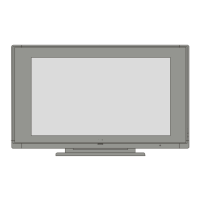
Do you have a question about the Matsui MAT37LW507E and is the answer not in the manual?
Details about operating voltage and outlet requirements for safe use.
Guidelines for handling and maintaining the power cord to prevent hazards.
Warnings against using the TV in damp conditions or near water.
Instructions for cleaning the TV safely using a soft, dry cloth.
Importance of keeping ventilation slots unobstructed for proper operation.
Advice on keeping the TV away from heat sources and open flames.
Recommendation to disconnect power during storms.
Emphasizes using manufacturer-specified parts for replacements.
Advises referring servicing to qualified technicians.
Guidance on proper disposal of packaging, batteries, and lamps.
Critical safety notes on attachment and unattended operation.
Instructions for setting up the TV with adequate ventilation space.
Important steps before powering the device for the first time.
Details on connecting the TV to the power supply (220-240V AC, 50 Hz).
Guide on connecting the aerial or cable TV plug to the TV.
Lists key features and capabilities of the television set.
Important note to switch off the TV before connecting external devices.
Steps for inserting batteries into the remote control handset.
Detailed explanation of each button on the remote control.
Diagram showing the TV's physical buttons and ports.
Diagrams showing various external equipment connection points on the TV.
Step-by-step instructions for powering the TV on and off.
Guide for the first-time setup process.
Guide for the automatic channel search and setup process.
How to use the TV's physical buttons for volume and program selection.
Using TV buttons to adjust volume level.
Using TV buttons to change channels.
How to access the TV's menu system using the 'M' button.
Switching the TV to external input modes.
Overview of remote control functions for TV operation.
Using remote control buttons for volume adjustment.
Using remote control buttons for channel selection.
Direct channel selection using number buttons.
Explanation of how to navigate the TV's menu system.
Details on adjusting picture settings like contrast, brightness, and colour.
Adjusting the contrast level of the picture.
Adjusting the brightness level of the picture.
Adjusting the sharpness of the picture.
Adjusting the colour saturation level.
Adjusting the hue for NTSC signals.
Selecting colour temperature (Cool, Normal, Warm).
Reducing image noise for better picture quality.
Optimizing picture for watching films.
Improving colour transitions and quality.
Resetting picture settings to factory defaults.
Adjusting the sound volume level.
Customizing sound frequencies using an equalizer.
Further options for equalizer settings.
Adjusting the audio balance between left and right speakers.
Adjusting volume and sound mode for headphones.
Selecting audio modes like Mono, Stereo, Dual.
Automatic Volume Limiting to maintain consistent sound levels.
Switching sound effects on or off for enhanced audio.
Enhancing bass effects and subwoofer options.
Setting an automatic turn-off timer for the TV.
Preventing unauthorized use of TV controls.
Selecting the on-screen menu language.
Configuring the Ext-2 output for various connection types.
Setting the default aspect ratio for displayed images.
Changing the appearance of the menu screen.
Adjusting how long menus remain visible.
Selecting the language for Teletext display.
Accessing settings for channel installation and search.
Selecting the radio frequency band for channels.
Changing or selecting TV channels.
Selecting the colour standard (PAL, SECAM, NTSC).
Selecting the audio standard (BG, DK, I, L).
Adjusting tuning for better signal reception.
Initiating an automatic or manual channel search.
Setting the TV for VCR or DVD input.
Saving current TV settings or programs.
Renaming TV programs.
Inserting a program into the program list.
Removing a program from the list.
Re-initiating the automatic channel scan.
Information displayed on screen like program number and mode.
Location of the mute status indicator.
How to freeze the current image on screen.
Changing the screen aspect ratio using different zoom modes.
Automatic zoom adjustment based on WSS signal.
Stretches 4:3 picture to fill wide screen.
Zooms 16:9 picture to full screen.
Selecting the input source for the TV.
Steps to activate and use the Teletext service.
How to navigate and select specific Teletext pages.
Accessing the Teletext index page.
Overlaying Teletext information on a TV program.
Displaying Teletext in double height for better readability.
Using coloured buttons for quick Teletext page access.
How TOP text mode operates and uses colour-coded buttons.
Connecting HD devices via HDMI or Component sockets.
Connecting devices using SCART cables.
Connecting devices without SCART to the aerial input.
Connecting a satellite decoder for unscrambled programs.
Connecting a decoder using an aerial cable.
Connecting a decoder using a SCART cable.
Connecting TV and VCR for better picture/sound quality.
Connecting an NTSC VCR for playback.
Selecting sources for VCR recording.
Storing test signal from VCR for optimal picture.
Connecting cameras and camcorders to AV input.
Connecting cameras or camcorders via S-VHS input.
Using EXT-2 S mode for better picture quality with S-Video.
Connecting a decoder to a VCR.
Connecting stereo headphones to the TV.
Connecting an external subwoofer for enhanced bass.
Connecting audio amplifiers or home theatre systems.
Instructions for cleaning the TV screen safely.
Troubleshooting common picture quality issues.
Troubleshooting steps for when there is no image on the screen.
Troubleshooting sound issues, including mute and balance.
Troubleshooting issues with the remote control.
Advice on when to contact a service engineer.
Visual guides for various aerial connection methods.
Visual guides for connecting external devices.
Diagram for direct aerial connection.
Diagram for aerial connection through a VCR.
Diagram for aerial connection via VCR and decoder.
Diagram for aerial connection via a decoder.
Visual guide for connecting headphones.
Visual guide for connecting a camcorder.
Supported TV broadcasting standards.
Supported channel frequency bands.
Specification for the RF aerial input connector.
Operating voltage and frequency requirements.
Audio system specifications (German+Nicam Stereo).
Audio output power rating.
Screen size and display type (16:9, 37" and 42").
Power consumption figures in normal and standby modes.
Physical dimensions of the TV with and without stand.
Supported video modes and aspect ratios via HDMI.
